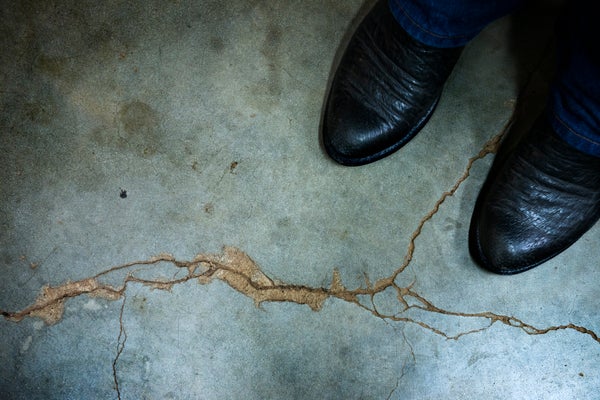Scientists have a new tool that could help them predict earthquakes induced by the effects of pumping wastewater from oil and gas operations deep underground—and it’s in orbit. A team of geophysicists analyzed more than three years of radar data from the Japanese Advanced Land Observing Satellite (ALOS) and found they could see the land deform above wastewater disposal wells near Timpson, Texas. Two years later, in 2012, a magnitude 4.8 earthquake rocked the area.
ALOS’s interferometric synthetic aperture radar (InSAR) marks an important addition to predicting induced, or human-caused, seismicity. A research team led by geophysicist Manoochehr Shirzaei at Arizona State University pulled monthly InSAR data from May 2007 to November 2010 and watched the ground rise three millimeters per year above a pair of wastewater wells around two kilometers apart. They plugged the data into their model of pore pressure—how tightly water is squeezed into the cracks in subsurface rocks. Increased pore pressure can strain underground faults and potentially cause them to slip, creating an earthquake. The team published their study today in Science.
The study is the first that the authors are aware of to directly measure the ground uplift from wastewater injection. “We know that when you inject fluid into the ground it causes surface deformation, but we’d never seen it,” Shirzaei says. “For this Timpson study area we got lucky and could see the deformation.” Shirzaei hopes the data will allow the team to answer questions like why some injection wells may generate earthquakes and others don’t.
On supporting science journalism
If you're enjoying this article, consider supporting our award-winning journalism by subscribing. By purchasing a subscription you are helping to ensure the future of impactful stories about the discoveries and ideas shaping our world today.
Using InSAR data, independent from underground measurements, is a huge advance, says Cliff Frohlich, associate director of the Institute for Geophysics at the University of Texas at Austin, who has studied the Timpson quake but was not part of this research. He was also impressed at how well the team could pick out a clean radar signal from all of the background noise, such as seasonal variations or plant cover. He cautioned, however, that other models might vary from Shirzaei’s. He also notes that whereas the uplift occurred above two injection wells, the actual earthquakes occurred directly beneath another pair of wells where there was little uplift, around 25 kilometers away from the wells that did lie below ground deformation.
Those two wells injected their wastewater much deeper than the wells situated below the uplift. Many underground features can influence earthquakes. Shirzaei’s model relies on factors such as the stiffness of the rocks, along with wastewater injection depth and volume to calculate the pore pressure in a region. In some places a lack of deformation might even signal higher pressures deep underground, if operators are injecting fluids into less pliable rocks, notes Justin Rubinstein, a geophysicist at the U.S. Geological Survey who also was not involved in this study.
Mark McClure, an adjunct professor for energy resources engineering at Stanford University, agrees that it would have been more satisfying if Shirzaei’s team had observed deformation above the deeper well, but he found it interesting that the model showed earthquakes occurring after wastewater injection rates began decreasing. Shirzaei thought this could be due to the time it takes for the fluid to filter through rock and reach the deep faults or additional stresses arising from the sudden cessation of injection operations. “If you stop injection today, it’s possible that earthquake activity goes on for the next decade or so,” he says.
Shirzaei hopes to expand the model to other areas in the central U.S. that have seen a sharp increase in earthquakes and are near oil and gas development, but he is limited by the amount of obtainable data. ALOS is not the only satellite that has InSAR capabilities, and space agencies typically offer the corresponding information for free. If Shirzaei pulled from multiple satellites, the data would be available every few days. Better reporting practices could help, too; Texas officials typically offer monthly data on wastewater injection volumes, yet officials in Oklahoma offer it daily, he says.
McClure agrees that the availability of data is “absolutely critical.” “States need to do a much better job of gathering the data and making it available to the public so these sorts of studies are possible,” he says. “Specifically, monthly injection volumes for every well.”

Credit: Amanda Montañez; Source: “Surface Uplift and Time-Dependent Seismic Hazard Due to Fluid Injection in Eastern Texas,” by Manoochehr Shirzaei et al., in Science, Vol. 353, Issue 6306; September 23, 2016.
